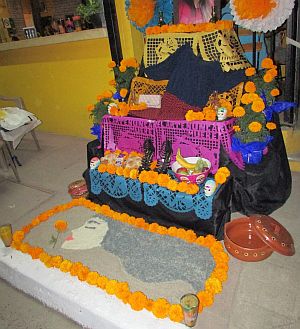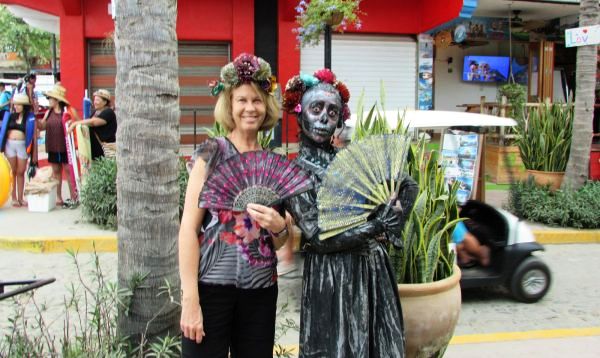Sayulita, Nayarit - Mexico celebrates many more holidays than the countries north of the border. Holidays are festive times, right? So, why is this something that can create culture shock? Let me try to explain with some examples.
Many Holidays are Unique to Mexican Culture
Día de Los Muertos, a very festive time in Mexico, means literally, Day of the Dead. A festival that revolves around death? I didn't understand it for years.
 |
The belief is that their departed love ones' souls join them to share this meal. This was difficult for me to understand when we first started traveling to Mexico. In the U.S., in non-Hispanic cultures, when we visit a grave-site, we feel sadness at the loss of our loved ones, certainly not a festive joy.
After living in this beautiful country for some time now, I have come to see this festival as a celebration of life, a time to remember and honor the people who have passed from this earth. The town plazas become a place where many colorful alters are built with flowers, food offerings, candles, sand and rocks, personal articles, and photographs, each honoring a deceased person.
Music and entertainment fill downtown with people mingling and strolling through the path between alters, admiring the artwork of each memorial, then moving on to enjoy the festivities. Later in the night, a long line of Mexicans can be seen walking from the plaza, through downtown and neighborhoods, to the cemetery, each carrying a lighted candle.
When first experienced, it appears that Día de Los Muertos revolves around death. Now I see that this celebration is a healthy way to remember the life of departed loved ones.
Holiday Noise Can Be Disturbing & Can Last for Days
In addition to all of the fun things such as parades, bands playing music in the plaza, residents and tourists dancing around the band, cowboys riding dancing horses, and children in costumes, there is an amazing amount of noise that reverberates across the town during [all Mexican] holidays.
Some holidays are accompanied by more noise than others, but for me, the holiday that was the most shocking was Our Lady of Guadalupe. The first year we lived there, I was startled awake by cannons going off downtown at 5:00 am to call the Catholics to church. Bella was barking and I wondered what the sound was, so loud we heard it clearly a half-mile away. I had just calmed her down and fallen back asleep, when the next cannon went off at 5:30 am. Another round of barking and falling asleep only to be jolted awake at 6:00 by a third cannon shot.
By then, Jon and I realized it must be cannons calling the Catholics to come to church for a service. That day, I asked around town, only to find out that each day during the week leading up to Our Lady of Guadalupe on December 12 begins with cannons and church bells! Each evening ends with fireworks. All of this early morning and late-night noise was culture shock at first. By the fifth or sixth morning, I didn't hear the cannons explode at all. I slept right through the sounds, and so did Bella.
 |
We had just moved into our new casita when one evening we noticed a crowd in front of our house, gathered around a large flatbed truck. As I watched, the children and adults chatted and worked together to create our neighborhood's float on the back of the truck. Many were working to decorate the truck, transforming it into a beautiful float.
Women were dressing the children as angels, wise men, the Virgin Mary, and other characters to fulfill the theme of their float. Excitement filled the air as the costumed children were lifted onto the float and helped into their assigned positions. It was fun to watch, a real community project. When the parade organizer gave the order, the float rolled away, driving toward the downtown plaza with a crowd of proud parents, grandparents, siblings, and neighbors walking along behind.
Then the fireworks begin around 10:00 pm. They can be heard all over town, startling us awake again, if we decided to go to bed early that night. Bella barks furiously. Other dogs can be heard barking in the neighborhood. When it finally quiets, I think, "Best if we get some sleep because this will start all over again at 5:00 am tomorrow..."
In addition to the holidays for saints and other church traditions, there are parades and celebrations in the streets for Mexican Revolution Day on November 20th. Emiliano Zapata's Birthday, August 8, provides another reason for boisterous, noisy celebration, as he was a leading figure in the Mexican Revolution.
Día de la Independencia, Independence Day in Mexico, celebrates the "cry of independence" on September 16. The "bombs," cannon booms, go off frequently for anything having to do with Revolutions and Independence.
There are also large parties for Quinceañeras (coming out at a 15-years old girl's birthday), smaller, yet elaborate baby showers, and fancy birthday parties for young children that morph into loud music, drinking, and dancing late into the evening. The loud music can be heard blocks away and may last until 5:00 am. The Mexican people love their fiestas and know how to stretch them out and extend their fun! Those of us who have moved to Mexico to enjoy all of its benefits must learn to adapt to the differences. Ear plugs are a necessity, sometimes even sound-cancelling headsets.
What we've learned is that maybe the Mexican Nationals have their priorities straight - family and fun come first. Work can wait - it will always be there. I enjoy living "On Mexican Time" now that I've adjusted to it. In fact, when we return to the United States for a few months, we wonder why everyone is in such a hurry, rushing to work, rushing home, stuck in rush-hour traffic. How did we ever live like that, and for as long as we did? Life is healthier, more enjoyable, when the pace is slowed down, and we are comfortable with that slower pace.
Read the full article for more information and photos.
About the Author
Terry L. Turrell loves to live and travel in Mexico, loves to eat quality food, and is hooked on Zumba! After living and traveling in their RV for years, she and her husband, Jon, have moved to a small home in Mexico. Her eBooks, "Healthy Living and Traveling in Mexico" and "Retirement Before the Age of 59: Healthy Living in Mexico #2," are now available on Amazon.com. They describe the Turrell's adventures in Mexico and the beautiful life they've lived along the way, the fun Zumba experiences they've have, and how to live healthy in Mexico. Terry invites you to "Follow" her blogs: RetirementBeforetheAgeof59, HealthyLivingandTravelinginMexico, and ZumbaMexico to see how much fun Mexico is, or visit her website, HealthyLivingandTravelinginMexico.com.


